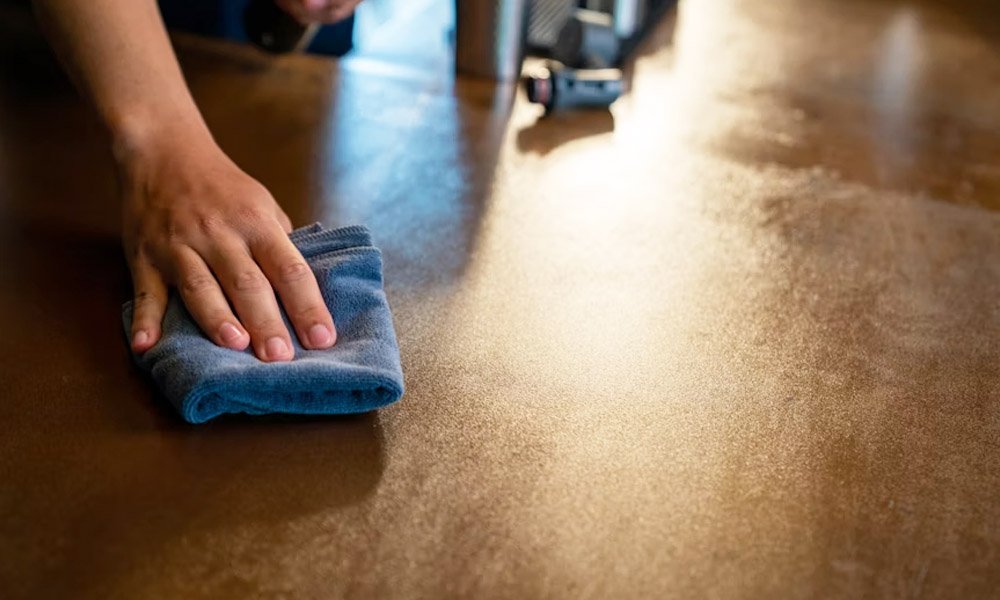Home
Picking Materials for Wet, Oily, or Gritty Floors
Published
4 months agoon
By
Archie
Floors in busy spaces take a beating. Water gets dragged in on boots. Oil drips from bikes or tools. Grit blows in from outside and sits in corners. When that happens, smooth surfaces turn slippery. People slow down, trips happen, and jobs take longer. A good floor fixes that. It gives steady footing, handles hits, and cleans fast. This guide keeps the choices simple so the right surface gets picked the first time.
Why these floors are tricky
Wet, oily, and gritty areas all fail in different ways. Water lowers friction, so feet and tyres can slide. Oil spreads thin and hangs around, turning a safe path into a skating rink. Grit acts like tiny marbles on hard floors and like sandpaper on soft ones. Most trouble starts in the first metre inside a door, at ramps, and in turning zones near benches and machines. If one patch looks worn every week, that’s where to focus.
What to check before choosing
Three questions help pick the right material. How much grip is needed when the floor is damp? What kind of loads roll or drop onto it? How fast must clean-up be during a workday? Add one more check: will water be able to leave, or will it get trapped? A surface with great texture still fails if puddles have nowhere to go.
Measure the area in more than one place. Walls and van sides are rarely perfect. Write down door heights, ramp angles, and where drains sit. Fewer seams make life easier. One big panel beats small strips that catch wheels and hold dirt.
Coated concrete and epoxy with grit
Paint with added grit can work well in lighter zones. It gives quick texture and seals the top against stains. Prep matters a lot. Dust, oil, or damp concrete can make the coat lift. In tight turning areas, the grit gets polished down. Touch-ups will be needed over time. This is fine for a home garage or a side room that sees light trolleys. In a wet loading spot, the coating can age fast unless the drain path is solid and shoes stay clean.
Rubber mats and tiles
Rubber feels steady underfoot and cuts noise. It absorbs small drops and helps when someone stands in one area for long periods. Interlocking tiles fit odd shapes and can be lifted to clean under them. The catch is movement at the edges if heavy carts twist on top. Cheap tiles can curl. Choose firm rubber with straight edges and pin or glue key corners. Some rubber mixes don’t enjoy oil, so check the product sheet if spills are common.
Vinyl and PVC tiles
These look neat and wipe clean. They suit dry rooms that see light to medium foot traffic. They do not enjoy sharp edges or heavy point loads. A dropped metal part can leave a dent or tear. For wet workshops and oily bays, a harder surface lasts longer.
Timber and board layers
Plywood and OSB spread weight well under benches and shelves. They cut noise and make a softer base under a hard top. Timber soaks water if unsealed, and edges near doors can swell. If timber is used, seal all faces and edges, then add a tougher layer over the busy paths. This combo works in sheds and service vans where a bit of flex is okay but the top still needs grip.
Metal tread plate for grip and impact
Tread plate, also called chequer plate, is a metal sheet with a raised pattern. Those bumps give shoes and tyres something to bite on. Aluminium versions stand out because they are strong for their weight and don’t rust in normal use. The thin oxide layer that forms in air protects the surface. That makes washdowns simple and helps in doorways, ramps, and bays.
Picking thickness is about load and base. Thin sheets work for foot-only steps. Mid thickness holds up to trolleys and tool chests. On soft timber, a thicker plate spreads force and stops dips. On solid concrete, mid thickness is usually enough. If a quick way to compare sizes and grades is needed, it helps to open full details on their aluminium plates and check options side by side before cutting.
Metal shines in zones that get hit or scraped a lot. The first metre inside a bay. The lip of a step. The ramp that sees rain and mud. It takes knocks that would chew up paint or vinyl and it wipes back to clean with a mop and mild soap.
Fibreglass grating in wet zones
Fibreglass reinforced plastic (often called FRP grating) has an open grid so water drains straight through. This helps near washdown areas and outdoor links. It gives steady footing and doesn’t rust. It can feel stiff under small wheels, and small items can drop through, so it’s best for walk paths, not for rolling heavy carts.
Drainage and the small details
No surface wins if water has no exit. Think about where the puddle goes. Leave thin gaps at the sides of ramps or add a small channel to a drain. Keep door thresholds smooth so wheels don’t bounce and spill. Use trims and stair nosings so edges don’t bite shoes. A slim paint band before a drop warns tired eyes. These details are small, but they make each step safer and faster.
Choosing for real life: a few clear examples
A service van with muddy boots and oil cans needs grip and dent resistance where feet land and wheels turn. A metal tread plate floor at the door and a strip across the threshold will handle that. A home garage with a hobby bench and light tool carts can do well with a firm rubber mat near the bench and a grippy coating in the middle path. A small warehouse corner where washdowns happen could use FRP walkways with metal plates at the entries and dock edges.
These setups are not fancy. They match the problem to the material. That’s the trick. Spend where the wear is. Save where it isn’t.
Simple fitting tips that prevent rattles
Prep the base. Sweep, vacuum, and degrease. Dry it fully. Mark cut lines with a straight edge. Support the offcut so panels don’t bend during cuts. Smooth sharp edges with a file. Dry-fit every panel before fixing. Check door swings and clearances.
Use the right fixings. On concrete, plugs and countersunk screws hold well. On steel, self-tapping screws grip. On timber, pre-drill and use screws with decent thread. Tighten spacing near edges and seams. Leave a slim gap at walls for heat movement and fill with flexible sealant so dirt and water can’t creep under.
Cleaning that keeps grip
Grit on any hard floor works against safety. Sweep first. Then mop with warm water and mild detergent. Rinse and let air dry. Oil spills lift with a basic degreaser; rinse after so there’s no film left behind. In winter, go easy on harsh rock salt on bare metal. Use a gentler de-icer and rinse later. If one landing patch starts to shine, add a short strip of anti-slip tape right where feet land. Replace it when worn. The floor keeps doing the heavy work; the tape takes the top scuffs.
Common mistakes to avoid
Guessing sizes leads to gaps or tight spots that snag. Measure in more than one place and sketch the plan. Using too few fixings lets panels flex, which loosens screws and opens seams. Ignoring drain paths creates puddles that never leave. Leaving raw edges sharp cuts boots and hands. Each of these has an easy fix: plan, fix low and often, keep water moving, and finish edges.
Budget and weight
Size and layout matter more than brand names. One large sheet that covers a path is better than three small panels with seams. Seams collect dirt and add time. Save offcuts for thresholds or shelf tops. In vehicles, weight matters. Aluminium saves kilos compared to steel, which helps with payload and fuel. In fixed shops, weight is less of a worry, so pick for grip and cleaning speed.
What to remember
Pick floors by problem, not by trend. Wet spots need texture and a way out for water. Oily zones need a hard skin that cleans without drama. Gritty paths need edges that still grip after months of boots and wheels. Plan the area, keep seams low, fit edges neatly, and give water an exit. Small, steady upgrades add up to safer steps, cleaner work, and fewer slowdowns. Choose one zone, make it solid, then move on to the next.
You may like


What You Should Know About the Best Website Development Services Before Hiring

Hulu Not Working on Your TV? Top Solutions to Try Today

Home Hacks vs. Clinic Care: Why You Should Never Try to Remove Your Own Skin Tag

Efficient Comfort Solutions with Ducted Gas Heating Systems

Global Sports Viewing Trends 2025—Real-Time Data Transforming the Spectator Experience

The Skills That Separate Successful Hunters from Everyone Else

The Role of Dua and Quran Recitation during Umrah

Maximising Home Energy: The Benefits of Solar Panel Battery Storage for UK Homeowners

10 Common Mistakes Sellers Make Without Amazon Data Analytics Software

The Essential Role of HIPAA Compliant CRM and Mailroom Management Software in Healthcare

Revolutionizing Healthcare: The Emergence of AI-Driven Analytics

Carol Kirkwood’s Journey: Her Real Age, Husband, Career, and More

How Machine Learning and AI are Redefining the Future?

Aliza Barber: Meet Lance Barber’s Wife, Age, Life, Profile, Career and Net Worth

Evelyn Melendez: Jordan Knight’s Wife Bio, Marriage, Family, Career and Net Worth

Ilan Tobianah Biography: Family, Marriage, Lifestyle, Career and Net Worth

King Von’s Autopsy Report: The Truth Behind the Tragic Death

Who was Alice Marrow? Everything to Know About Ice-T’s and His Mother

Body Positivity and Bodycon: Embrace Your Shape with Homecoming Dresses

Meet Otelia Cox: The Supportive Wife of Tony Cox – A True Fairy Tale Romance

What You Should Know About the Best Website Development Services Before Hiring

Hulu Not Working on Your TV? Top Solutions to Try Today

Home Hacks vs. Clinic Care: Why You Should Never Try to Remove Your Own Skin Tag

Efficient Comfort Solutions with Ducted Gas Heating Systems

Global Sports Viewing Trends 2025—Real-Time Data Transforming the Spectator Experience

The Skills That Separate Successful Hunters from Everyone Else

The Role of Dua and Quran Recitation during Umrah

Maximising Home Energy: The Benefits of Solar Panel Battery Storage for UK Homeowners

10 Common Mistakes Sellers Make Without Amazon Data Analytics Software

The Essential Role of HIPAA Compliant CRM and Mailroom Management Software in Healthcare
Category
Trending
-

 Health2 years ago
Health2 years agoRevolutionizing Healthcare: The Emergence of AI-Driven Analytics
-

 News4 months ago
News4 months agoCarol Kirkwood’s Journey: Her Real Age, Husband, Career, and More
-

 Technology2 years ago
Technology2 years agoHow Machine Learning and AI are Redefining the Future?
-

 Celebrity2 years ago
Celebrity2 years agoAliza Barber: Meet Lance Barber’s Wife, Age, Life, Profile, Career and Net Worth
